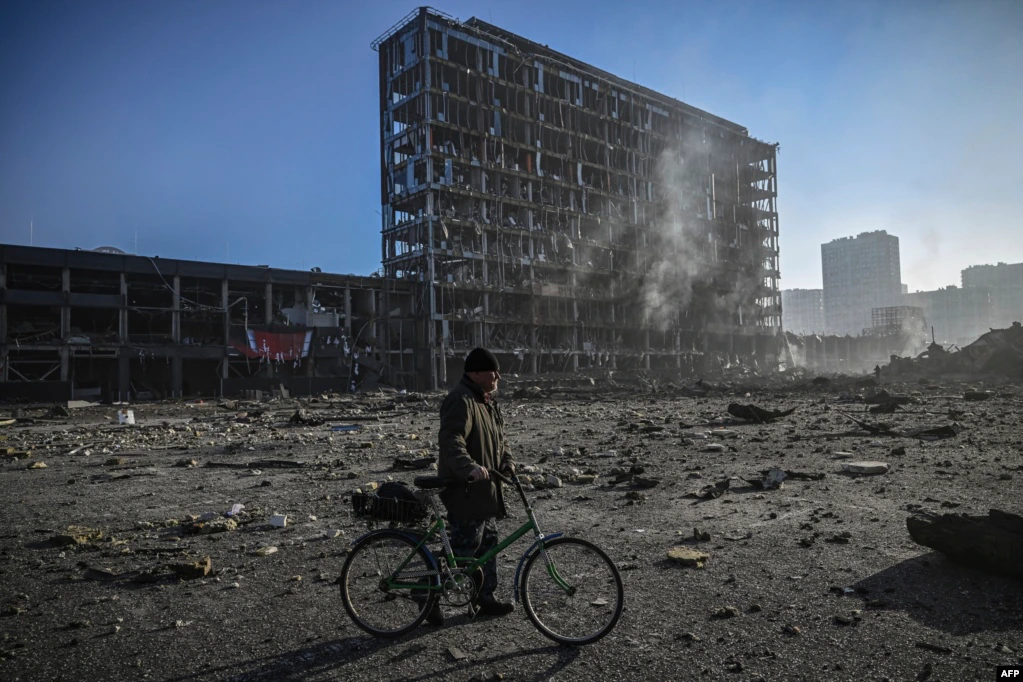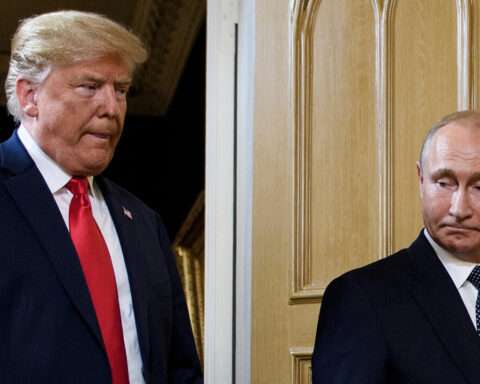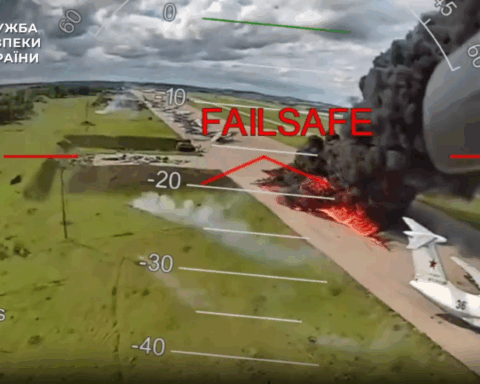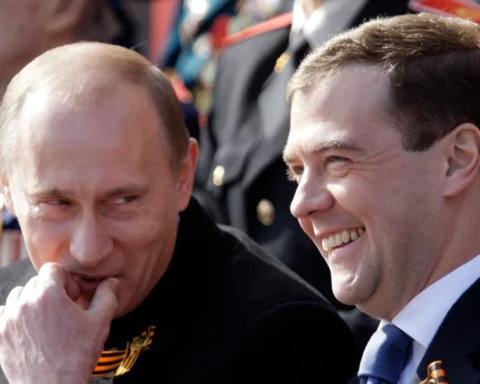KYIV — Wartime: – At a bar in Ukraine’s capital on a Monday night, the host of a stand-up comedy show offers a straightforward introduction: “We tell jokes and you laugh. It’s as simple as that.”
And for a while, in the room full of people and glasses of beer, it does seem that simple — until one of the comedians cracks a joke in Russian.
“I don’t think it’s funny to perform in Russian when our boys are dying every day and night on the front line,” says a man in his 40s who introduces himself as a civil activist.
The comic’s face goes pale and a young woman sitting in the back of the room stands up and tries to help him out.
“Everybody should decide what language they speak on their own,” she says, adding that she chose to switch from Russian to Ukrainian despite her Belarusian roots.
Unable to turn the situation into a joke, the comic cuts his set short and steps away, leaving the audience puzzled.
“It’s a stand-up show, so let’s not go into that,” says the host, comedian Dmytro Kharchenko, inviting another performer onstage.

The show goes on, but the spell is broken — the disruption has brought Russia’s unprovoked war into the bar on Khreshchatyk, the main street of a city struggling for a sense of normalcy as fighting rages on front lines to the east and south and lives are destroyed daily nearly six months after Russia’s February 24 invasion.
That struggle plays out innumerable times in Kyiv every summer’s day.
“You can get used to anything,” says a middle-aged man, sitting on a beach on an island in the Dnieper River near central Kyiv, as a woman nearby kissed her little son and walks to the water for a swim just as an alert siren goes off — as they do nearly every day in the capital. The boy smiles and keeps on building his sandcastle.
In the heart of the city, just uphill from the square known as the Maidan and next to a church that served as a hospital for protesters during 2013-14 uprising that was centered there, families take photos in fire-blackened Russian tanks and military equipment on display — relics of a war that is still being fought and appears far from over.
The damaged vehicles are trophies from what’s known as the Battle of Kyiv — the crucial showdown in the first six weeks or so after the invasion, when Russian forced poured across the border, some from Belarus, and drove southward toward Kyiv but failed to take the capital.
They then retreated, leaving stunned, grieving survivors and evidence of atrocities in the devastated cities and towns north, east, and west of Kyiv that they had occupied.
Invincible Summer?
The capital itself was also targeted and repeatedly hit by bombs, rockets, and shells as many residents fled or sheltered on subway platforms beneath the streets. But it escaped the worst of the Russian assault in northern Ukraine, and many who left have returned, despite the continued risk.
Against the backdrop of fierce fighting in the Donbas and new battles looming in the south, residents of relatively safe Kyiv are exploring the new wartime normal.
At the height of summer, sandy beaches on the banks of the Dnieper are full of people sunbathing, swimming, and having fun; traders sell cherries, peaches, and watermelon; restaurants, cafes, and pubs are once again bustling with life.

An 11 p.m. curfew means the city can be eerily quiet at night. But during the day the streets around Independence Square — the Maidan — are almost as overloaded with cars as they used to be before the February 24 invasion, when the war was limited to the parts of eastern Ukraine known as the Donbas.
According to the authorities, there are now about 3 million Kyiv residents in the capital, whose population was 3.6 million before the invasion. On top of that, about 100,000 internally displaced people have come to Kyiv from other regions of the country.
Most of them take the frequent air-raid sirens in stride. But the mayor, Vitali Klitschko, says that they are not just background noise, and that the sandbags towering around the monuments, checkpoints at subway stations, and ever-present armed soldiers are there for a reason.
“The good weather and peaceful atmosphere are an illusion,” he told the Daily Telegraph in an interview. “The city can be attacked from the air at any point in time.”
While “there can be no talk of normality in a time of war,” he said, “citizens are doing their best to adapt to the difficult conditions.”
They are also facing new problems.
‘Preserve Some For The Winter’
More than 600 residential buildings and pieces of infrastructure have been damaged by Russian strikes on Kyiv — some of them very badly. But unlike the places that were occupied by Russians, such as Bucha, Borodyanka, and Irpin, physical damage inflicted by the war is not visible all over the capital.
The authorities have vowed to complete the renovation of 11 damaged residential high-rises by autumn so that everybody in Kyiv who lost their home can come back.
The onset of cold weather is a big source of anxiety for Kyiv residents. Apartments are to be supplied with heat starting in mid-October, and residential rates are supposed to remain stable. But fuel prices, personnel shortages, and destroyed enterprises — all resulting largely from Russia’s invasion — create uncertainty.

Rising consumer prices are also causing a lot of concern. They have increased by 21 percent over last year, according to the central bank, and by 35 percent in the case of food. The country’s economy is expected to contract by more than one-third this year.
Vendors at the iconic Zhytniy Market, a modernist building in the Podil district built on a site where trade has been conducted for over five centuries, complain of falling demand.
“Potatoes, cabbage, and onions are selling as usual, but people have started to give up on the more expensive products they can do without,” says Olena, a woman selling fruit and vegetables. “But, fortunately, most of my regular customers have returned to the city.”
Another seller, asked how she sees the future of her business, responded by urging a potential customer to stock up while supplies last: “Buy some fresh berries from the forest before summer’s over. You should preserve some for the winter,” she said.
To help avert a financial crisis and keep inflation under control, the central bank devalued Ukraine’s hryvnya currency by 25 percent against the dollar in late July. Currency exchange offices have been banned from displaying the exchange rate, so boards with the hryvnya, dollar, and euro symbols shine blank.
“They should also ban the display of food and fuel prices — then everyone would be happy,” jokes a man sipping coffee next to the market.
President Volodymyr Zelenskiy is a former comedian who has become a symbol of defiance since the invasion, and a sense of humor in the face of a deadly threat has become part of Ukraine’s new global image.
Collective Trauma
But beneath the surface, the picture is more complex, as the tension that erupted at the comedy show at the Bochka bar on Khreshchatyk showed.
“Many people have witnessed death and destruction and almost everybody is constantly exposed to it on social media,” says Viktoria Semko, a psychologist and psychotherapist from Irpin, a hard-hit city just northwest of Kyiv, who runs a support group for people affected by the invasion.
Semko, who fled her hometown when the Russian shelling started, believes that the shared experience of fear, anger, and hate created an enormous amount of energy that now manifests itself in both positive and destructive ways.

“The collective trauma of the first months of war unified people beyond the level possible under normal circumstances,” she says. “The past few months have been a time of existential realizations that enabled many people to redefine their identity and act in ways sometimes surprising even to themselves.”
But survivors are also struggling to cope with constant stress, she says: “Many of my clients suffer from apathy or panic attacks or project their anger onto other people, such as family members.”
Semko says that social tension reached a climax when the Kyiv region was unoccupied and now people — with families torn apart and the preinvasion way of life now impossible for most of them — have started to question their choices and worry about the future.
“It’s a fragile balance between a reclaimed sense of control and anger stemming from the experience of trauma,” she says. “But for certain, those who are staying here know what’s at stake and what their priorities ar
e.”






